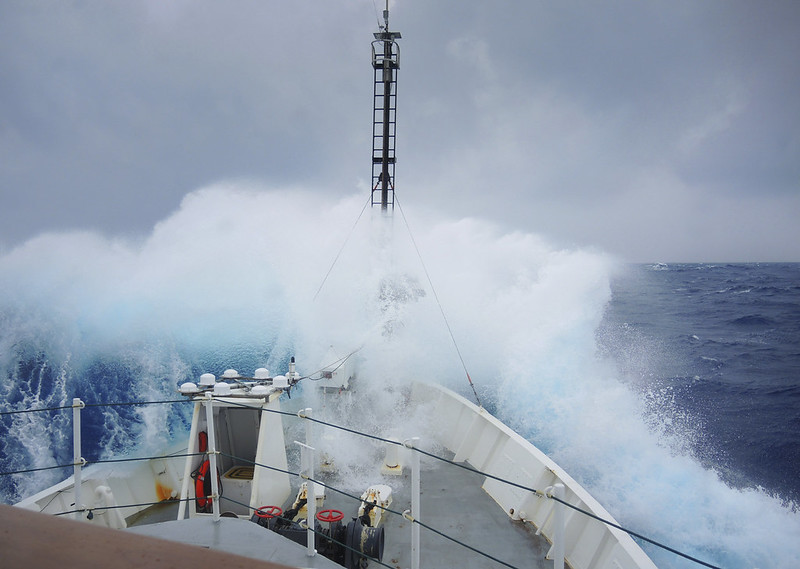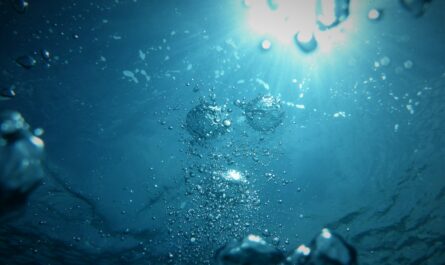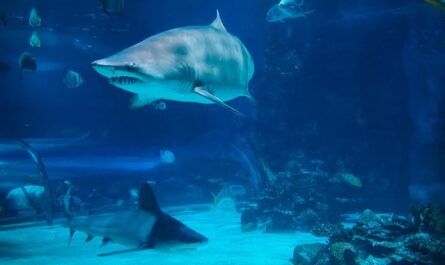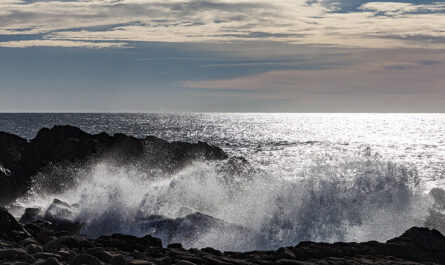The Sargasso Sea, a vast stretch of the North Atlantic Ocean, is a unique and fascinating marine ecosystem, distinct from any other place on Earth. Unlike most seas, which are defined by their proximity to land, the Sargasso Sea has no land borders. Instead, it is a floating ecosystem, bounded by ocean currents on all sides. This expansive region, named after the floating Sargassum seaweed that dominates its waters, harbors a rich diversity of marine life and plays a vital role in global oceanic processes. However, the Sargasso Sea is also facing increasing threats from human activity, climate change, and pollution, making its preservation a pressing environmental issue.
In this article, we’ll explore the Sargasso Sea’s unique characteristics, its ecological importance, the species that rely on it, and the challenges it faces in an era of environmental uncertainty.
What is the Sargasso Sea?
The Sargasso Sea is located in the North Atlantic Ocean, roughly between 20° and 35° North latitude and 30° to 70° West longitude. It lies within the North Atlantic Subtropical Gyre, a system of ocean currents that includes the Gulf Stream, North Atlantic Current, Canary Current, and North Atlantic Equatorial Current. These currents form a large, clockwise circulation pattern that creates a calm, relatively stable body of water in the middle—this is the Sargasso Sea.
What sets the Sargasso Sea apart from other marine ecosystems is its lack of land boundaries. Unlike seas that are partially enclosed by continents or islands, the Sargasso Sea is entirely defined by the currents that encircle it. As a result, its waters are typically warmer and more saline than the surrounding ocean, creating unique conditions for the species that call it home.
The sea is named after the floating mats of Sargassum, a type of brown seaweed that is found in abundance here. Unlike other seaweeds that anchor to the seafloor, Sargassum is free-floating, drifting across the ocean surface. These large mats of seaweed provide a habitat for a variety of marine species, forming a floating ecosystem that supports life both above and below the waterline.
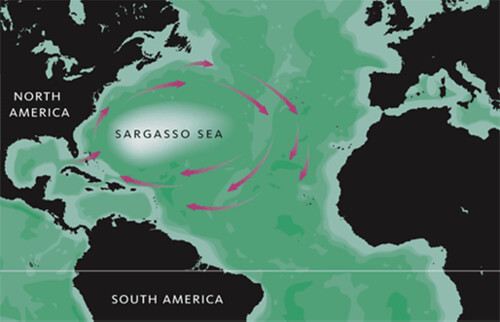
The Role of Sargassum in the Ecosystem
The floating Sargassum in the Sargasso Sea serves as the foundation of a rich and diverse ecosystem. These mats of seaweed offer shelter, food, and breeding grounds for a wide range of marine organisms, making the Sargasso Sea a critical habitat for many species.
A Nursery for Marine Life
One of the most important roles the Sargasso Sea plays is as a nursery for a variety of marine species. The dense mats of Sargassum provide protection from predators and a rich source of food for juvenile fish, crustaceans, and other small marine creatures. For many species, the Sargasso Sea serves as a vital early-life habitat, allowing them to grow and mature before migrating to other parts of the ocean.
One of the most notable species that rely on the Sargasso Sea as a nursery is the European eel (Anguilla anguilla) and the American eel (Anguilla rostrata). Both species spawn in the Sargasso Sea, with their larvae traveling thousands of miles across the Atlantic to the rivers and coastal waters of Europe and North America, where they mature. After spending many years in these freshwater environments, the eels return to the Sargasso Sea to spawn and complete their life cycle. This remarkable migratory journey is one of the many mysteries of the Sargasso Sea and highlights its importance as a breeding ground for marine life.
Biodiversity Hotspot
The Sargasso Sea is home to a wide array of marine species, including fish, turtles, birds, and invertebrates. Some species are found exclusively in this region, while others, like migratory fish and sea turtles, depend on the Sargasso Sea during specific stages of their life cycles.
Fish: The floating Sargassum mats provide a habitat for a variety of fish species, including juvenile swordfish, tuna, and mahi-mahi, which find refuge among the seaweed. The Sargasso Sea is also home to the endemic Sargassum fish (Histrio histrio), a small, well-camouflaged fish that uses its pectoral fins to cling to the seaweed and ambush prey.
Sea Turtles: The Sargasso Sea is a critical habitat for juvenile sea turtles, particularly loggerhead and green turtles. After hatching on beaches in the Caribbean and the southeastern United States, these young turtles make their way to the Sargasso Sea, where they spend the early years of their lives in the relative safety of the Sargassum mats. Here, they find ample food and shelter from predators, allowing them to grow and develop before returning to coastal waters.
Birds: The Sargasso Sea is also important for migratory bird species. Seabirds, such as terns and shearwaters, rely on the abundance of fish and other marine organisms found in the Sargasso Sea. These birds use the floating seaweed as a resting place during long migratory journeys across the Atlantic.
The Sargasso Sea and Global Ocean Health
Beyond its role as a habitat for marine life, the Sargasso Sea plays a crucial role in global oceanic processes, particularly in carbon cycling and ocean circulation.
Carbon Sequestration
The Sargasso Sea contributes to the global carbon cycle through a process known as the biological pump. As plants, plankton, and algae grow and die in the ocean, they absorb carbon dioxide (CO₂) from the atmosphere. When these organisms die, their carbon-rich remains sink to the ocean floor, effectively removing CO₂ from the atmosphere and storing it in the deep ocean. The Sargasso Sea, with its abundance of plant life in the form of Sargassum, plays an important role in this process, helping to mitigate the effects of climate change by sequestering carbon.
Ocean Circulation
The Sargasso Sea is located within the North Atlantic Subtropical Gyre, a system of currents that has a significant impact on global ocean circulation. The warm waters of the Sargasso Sea are transported northward by the Gulf Stream, which helps regulate the climate in the North Atlantic region. The movement of warm water from the tropics to higher latitudes is essential for maintaining the Earth’s climate system, influencing weather patterns and temperatures across Europe and North America.
Threats to the Sargasso Sea
Despite its ecological importance, the Sargasso Sea is facing a range of threats from human activities, including pollution, overfishing, and climate change. These threats not only endanger the unique marine life that depends on the Sargasso Sea but also undermine its role in global ocean health.
Plastic Pollution
One of the most pressing threats to the Sargasso Sea is plastic pollution. Ocean currents that define the boundaries of the Sargasso Sea also trap floating debris, including plastic waste, which accumulates in the region. This has led to the formation of a “garbage patch” within the Sargasso Sea, similar to the more well-known Great Pacific Garbage Patch.
Plastic debris poses a significant threat to marine life. Animals that mistake plastic for food can suffer from blockages in their digestive systems, which can be fatal. Additionally, microplastics—tiny plastic particles that result from the breakdown of larger items—can enter the food chain, accumulating in the bodies of marine organisms and potentially making their way into human diets.
Efforts to reduce plastic pollution in the Sargasso Sea and the broader Atlantic Ocean are crucial for protecting this fragile ecosystem. International cooperation is needed to tackle the problem at its source by reducing plastic production, improving waste management, and removing debris from the ocean.
Overfishing
The Sargasso Sea is also at risk from overfishing, particularly of migratory species such as tuna and swordfish, which use the sea as a nursery and feeding ground. Industrial fishing fleets often operate in international waters near the Sargasso Sea, targeting these species with little regard for the impact on the ecosystem. Overfishing can lead to the depletion of key species, disrupting the food web and threatening the long-term health of the Sargasso Sea.
Efforts to regulate fishing activities in the region, such as the creation of marine protected areas (MPAs), are essential for ensuring the sustainable management of fish populations and the preservation of the Sargasso Sea’s biodiversity.
Climate Change
Climate change poses a long-term threat to the Sargasso Sea, particularly through its impact on ocean temperatures and circulation patterns. As global temperatures rise, the waters of the Sargasso Sea are becoming warmer, which could affect the distribution of species that depend on specific temperature ranges. Additionally, changes in ocean circulation patterns could alter the flow of currents that define the boundaries of the Sargasso Sea, potentially disrupting the delicate balance of the ecosystem.
The Sargasso Sea’s role in carbon sequestration also makes it vulnerable to the effects of climate change. If the biological pump is disrupted, the ability of the ocean to absorb and store carbon could be diminished, exacerbating the problem of atmospheric CO₂ and contributing to global warming.
Conservation Efforts: Protecting the Sargasso Sea
Recognizing the importance of the Sargasso Sea, efforts have been made to protect this unique ecosystem from the growing threats it faces. In 2010, the Sargasso Sea Commission was established under the leadership of the government of Bermuda, with support from international partners. The commission’s mission is to conserve the Sargasso Sea’s ecosystem through research, advocacy, and the development of protective measures.
One of the key goals of the Sargasso Sea Commission is to secure international recognition for the Sargasso Sea as a High Seas Marine Protected Area. Such designation would provide legal protection against activities that threaten the health of the ecosystem, such as overfishing and pollution. The commission is also working to raise awareness about the Sargasso Sea’s ecological importance and to promote sustainable practices that will ensure its preservation for future generations.
Conclusion
The Sargasso Sea is a mysterious and vital part of the North Atlantic Ocean, offering a glimpse into a floating ecosystem unlike any other on Earth. Its floating mats of Sargassum seaweed provide shelter, food, and breeding grounds for a wide range of marine species, while its role in global carbon cycling and ocean circulation underscores its importance to the planet’s health. However, the Sargasso Sea is under threat from human activities, and its preservation is more critical than ever.
Through international cooperation, research, and conservation efforts, there is hope that the Sargasso Sea can continue to thrive as a sanctuary for marine life and a vital component of the world’s ocean ecosystems. By understanding and protecting this floating wilderness, we can ensure that the mysteries of the Sargasso Sea continue to inspire and sustain life for generations to come.
